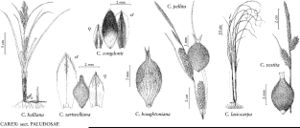Difference between revisions of "Carex vestita"
Sp. Pl. 4(1): 263. 1805.
FNA>Volume Importer |
FNA>Volume Importer |
||
| Line 47: | Line 47: | ||
|publication year=1805 | |publication year=1805 | ||
|special status= | |special status= | ||
| − | |source xml=https://jpend@bitbucket.org/aafc-mbb/fna-data-curation.git/src/ | + | |source xml=https://jpend@bitbucket.org/aafc-mbb/fna-data-curation.git/src/f6b125a955440c0872999024f038d74684f65921/coarse_grained_fna_xml/V23/V23_926.xml |
|genus=Carex | |genus=Carex | ||
|section=Carex sect. Paludosae | |section=Carex sect. Paludosae | ||
Revision as of 19:10, 24 September 2019
Plants colonial; rhizomes long-creeping. Culms lateral, trigonous, 25–90 cm, scabrous-angled. Leaves: basal sheaths reddish purple, bladeless, apex of inner band glabrous; ligules 1.2–9 mm; blades green, M-shaped, 2.2–5.5 mm wide, glabrous or finely pubescent beyond ligule. Inflorescences 3–10 cm; peduncles of terminal spikes 2–20 mm; proximal 1–2(–3) spikes pistillate or androgynous, ascending; distal spikes erect; terminal 1(–2) spikes staminate. Pistillate scales ovate, apex acute to acuminate, glabrous, apical margins often scabrous-ciliate. Perigynia ascending, 10–14-veined, broadly ovoid, 2.8–4.5 × 1.3–2.1 mm, densely pubescent, pubescence nearly concealing veins and cellular details; beak 0.9–1.4 mm, friable, erose.
Phenology: Fruiting May–Jun.
Habitat: Dry to moist, open, sandy or gravelly meadows, open woods in acidic soils
Elevation: 0–400 m
Distribution

Ala., Conn., Del., D.C., Maine, Md., Mass., N.H., N.J., N.Y., N.C., Pa., R.I., Tenn., Va.
Discussion
Carex vestita is long persistent in shaded conditions and is stimulated to flower and fruit by fire or other disturbance.
Selected References
None.
